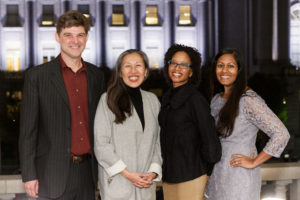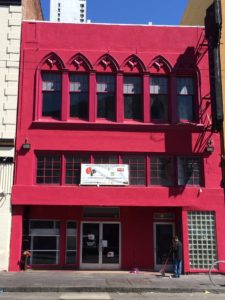
For me, it begins with DANCE. And it’s dance, performance, and teaching that expanded my lens of the arts, my commitment to it, and passion for it.Rooted in the spiritual, performative traditions of the African diaspora, I specialize in Cuban and Peruvian folkloric practices, and explore the ritual movements of Brazil and Haiti.
To my peers and colleagues, I am a cultural equity specialist and community connector. In my professional voice: ‘I’m a nonprofit arts administrator working at the intersection of arts, community economic development, philanthropy, and policy.
My Bay Area arts journey led me from a stint as an intern with Dancers’ Group, to the 40-year-old San Francisco Ethnic Dance Festival as assistant to the artistic directors, to my artist family at EMESE: Messengers of the African Diaspora; from grantmaking with a racial equity lens at the San Francisco Arts Commission, to principal dancer with De Rompe y Raja, to real estate development. WHAT???!!!
The last place I saw myself was in real estate, yet CAST (Community Arts Stabilization Trust) is the place where I’m able to draw from my background to keep the artistic soul of our cities alive and thriving while the Bay Area region braces itself during this affordability crisis. I never imagined the opportunity!
So, let me give you a glimpse into CAST…
CAST Origin Story
In 2012, CAST emerged out of a brilliant partnership between Shelley Trott, Director of Arts Strategies and Ventures at the Kenneth Rainin Foundation and Joshua Simon, former Director of Real Estate Consulting at the Northern California Community Loan Fund (NCCLF). Recognizing the tech boom was once again creating a surging and relentless real estate market for arts organizations vulnerable to an unprotected commercial real estate market, both Trott and Simon embarked on a mission to ensure artists would remain in our cities regardless of market changes. They created a permanent solution in the Community Arts Stabilization Trust.
Soaring rents have created an impenetrable market for artists, increasing commercial rental rates for arts organizations from $1.50/square foot/month to $5.00 in San Francisco, according to a 2015 TODCO Group study on artists located in the South of Market. Oakland rental rates follow closely behind San Francisco’s, with commercial landlords patiently waiting for the market to peak, signing only one to three year leases. It’s absolutely absurd to think that arts nonprofits would be able to afford office space that has increased by 122% in the last five to six years.
With an $8.3 million philanthropic investment into the organization, the Rainin Foundation calls CAST a “game-changing” model for stabilizing the arts sector and preserving the cultural character of our cities. In the words of Simon, now a CAST Board member, “CAST disrupts the ‘space chase’ by freezing real estate prices.”

CAST in Action
In 2013, CAST became a nonprofit real estate development and holding company strictly for the arts. We create long-term solutions to develop, acquire, and provide safe, affordable workspaces for artists and arts organizations. To address the wealth disparity, CAST employs three strategies with a priority and focus on long-term impact, affordability, and accessibility:
- Acquisition/Ownership model is demonstrated in CAST’s first two projects: CounterPulse, an experimental performing arts venue, and Luggage Store Gallery, a 30-year-old, community-driven, culture hub. They now have permanent homes in the heart of San Francisco––the Central Market and Tenderloin neighborhoods––with below-market-rate rents. And, most importantly, both arts institutions have seven to ten years to build their capacity to manage their facilities and buy back their buildings from CAST at the price we paid for it in 2015. At that point, they become the sole owners of their respective ‘homes’. Once CAST receives final payment for these properties, CAST will recycle these funds to purchase another building, strictly for the arts.
What’s unique about this model is that if they happen to outgrow their spaces and need to move out, these buildings will forever remain in the arts community as deed-restricted properties strictly for arts and culture use. Both arts organizations’ buildings are now open and activated, together serving 95,000 people annually.
- Multi-tenant model will be piloted in two projects. The multi-tenant arts center model allows an arts organization to access CAST’s services without having to jump into ownership. CAST provides a long-term commercial lease to the arts organizations at below-market rental rates. This way, the artist focuses on the creative work, plus activating neighborhoods, and cultural and community spaces.
The 447 Minna project was CAST’s first venture into partnering with a national real estate development company. Forest City will gift CAST a historic,12,000 square foot brick building located in the heart of 5M––a four-acre, mixed-use development in the South of Market neighborhood in San Francisco. CAST will create a community and cultural hub to preserve arts space for this rapidly changing neighborhood. Activation is projected for 2020.
CAST’s latest project, the Geneva Car Barn, is located in the Excelsior, a San Francisco neighborhood with the highest population of families. The GCB project is a long-term partnership with the City of San Francisco’s Recreation and Parks Department to reactivate the long-neglected, “gorgeous ruin”––playfully described by our Executive Director, Moy Eng––into a youth and family center for the arts. Activation is projected for 2019.
- Mission-aligned Initiatives complement CAST’s real estate development efforts with research and short-term/intermediate solutions, such as:
- The San Francisco Nonprofit Displacement Mitigation Fund: We partnered with the San Francisco Arts Commission and NCCLF to award $1.2 million in space grants to 14 San Francisco arts organizations to address the immediate impacts of the real estate crisis.
- Keeping Space – Oakland: A training and funding program for Oakland arts organizations seeking real estate assistance. This pilot program aims to build the capacity of arts groups to help them successfully take on a real estate transaction. We recently awarded over $350,000 to 14 Oakland arts and cultural groups, organizations, and collectives for real estate-related projects across building purchases, planning, and facility improvements, including code and safety.
- CAST’s Cultural Assets Map: Scheduled to be launched by spring 2018, this initiative will map San Francisco’s cultural facilities, be a tool for users to learn about the San Francisco arts landscape, and provide key information that could help influence investment, policy, and grant making decisions.

CAST’s Success Factors
Five years in, CAST is a high-performing team of six cultural workers with a shared vision to bring stability to the Bay Area arts sector through real estate development and initiatives. Suneetha Venigalla is CAST’s commercial real estate expert responsible for negotiating the next 100,000 square feet of space in the pipeline for artists and arts organizations in San Francisco and Oakland. With $27.4 million raised for our current projects, $6.7 million remain to be financed and raised by the end of this year with guidance from CAST’s finance expert, Owen Levin.
Preceding CAST’s visionary leader, Moy Eng, who brings over 30 years of experience in the fields of arts, human rights, and philanthropy, are CAST’s accomplished, founding Board of Directors. CAST’s directors collectively offer significant expertise in San Francisco Bay Area real estate development, philanthropy, community development, marketing, high-tech ventures, and social enterprise. In fact, CAST Board President, Steven Oliver, began an investment fund for artist housing over 15 years ago during the first dot-com boom in the Bay Area.
The arts are now at the table in multi-sector conversations across economic and community development, real estate, and beyond to create a new philanthropic strategy. We could not do this without our public-private partnerships with the Kenneth Rainin Foundation, William and Flora Hewlett Foundation, Northern California Community Loan Fund, City of San Francisco, Oakland Mayor’s Office, and many others.
Moving Forward
CAST has experienced exceptional growth since its inception. After presenting at 2017 SHIFTForum, the Federal Reserve Bank of San Francisco, and Grantmakers in the Arts, CAST will continue to share its model locally, nationally, and internationally at the World Cities Culture Summit 2018, to be held in San Francisco this year.
Looking ahead, we ask ourselves the following questions:
- How do we meet the demand for space in an exorbitant real estate climate and multi-year real estate development process?
- What fundraising mechanisms exist to build a capital fund to acquire property when the opportunity presents itself?
- How do we remain nimble and adaptive as we’re building the CAST ship, while sailing it?
There are so many more questions with which we’re grappling, but in a few pages, that’s what we do and where we’re at on our journey. Got it?
I know…I’m still learning, too, and enjoy that there’s never a dull moment at CAST. We’re all learning together, putting our heads together to protect artists from the market forces and ensure the cultural character of our cities remain, as they rapidly change. I look forward to seeing you at our next ribbon-cutting event!
This article appeared in the March 2018 edition of In Dance.

